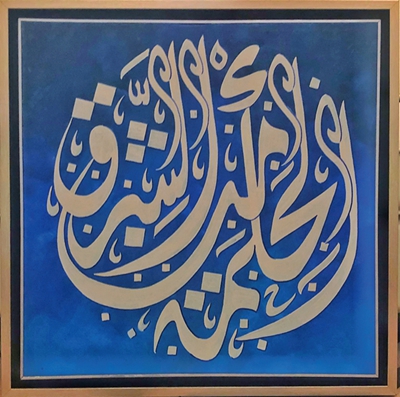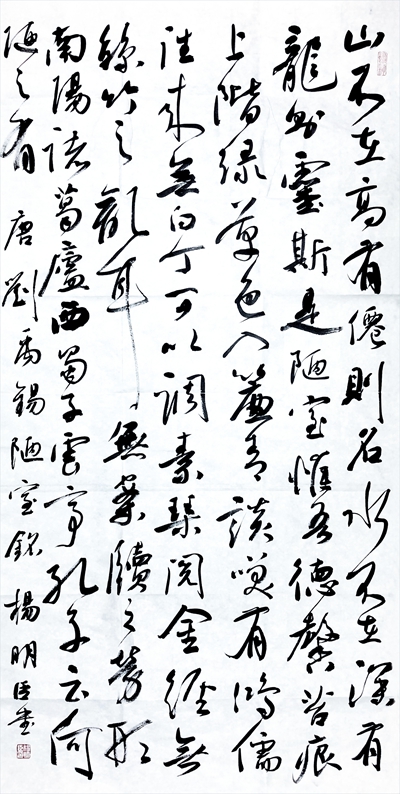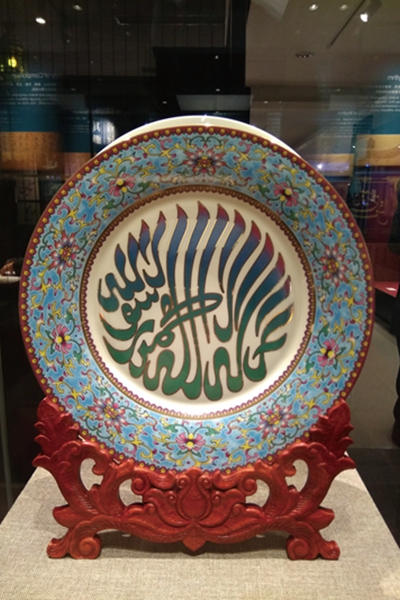Chinese-Arabic Calligraphy Demonstrates Oriental Wisdom

Works of Saudi Arabian calligrapher

Arabic calligraphy

Works of YANG Mingchen

Works of WANG Xueling

Exhibits with Arabic calligraphy in the exhibition
"Arabic calligraphy has a strong sense of lines with hardness amid soft genre, and fully absorbs and reflects the combination of Yin and Yang in the Chinese culture. Due to the differences in writing instruments, Chinese characters calligraphy is bold and magnificent, and inked on rice paper, and Arabic calligraphy is rigorous and delicate.Through the writing of Islamic sages’mottos, it provides people with spiritual food and demonstrates the unique aesthetics embodied in Islamic culture."On March 30th, the Oriental Wisdom-Saudi China Calligraphy & Culture Exhibition, organized by China Calligraphers Association and Saudi Arabia King Abdulaziz Public Library-Peking University Branch, has been held amid the opening ceremony of the latter institution. During the occasion, SU Shishu, President of CCA made the remarks to the attending participants.
Demonstrated by means of texts, works, documents, and multimedia techniques, the Oriental Wisdom-Saudi China Calligraphy & Culture Exhibition has showcased the core cultural concepts, artistic characteristics, classic works of Chinese and Arabic calligraphy and the creative achievement of contemporary Chinese and Arabic calligraphers.The exhibition takes calligraphy art as an entry point to showcase the cultural origins of both parties and the achievements of civilization, playing the role as an exchange of art, a dialogue of civilizations and a tribute to history.
Chinese calligraphy, a unique art form established by the Chinese nation in the process of writing Chinese characters for thousands of years, is a representative element of oriental art with a profound cultural heritage and population foundation.Through the writing of Chinese characters, while completing the practical functions of expressions, it integrates people’s perceptions of nature, society, life and living in a unique expression form and brush-and-ink rhythm, thereby expressing people’s philosophical thoughts, personality, emotions andinterests. However, the Arabic calligraphy is an actual record of Arab art and the development of Islamic civilization.The keen observation, rich imagination, rigorous techniques and craftsmanship of calligraphers have contributed to the improvement of calligraphy art. All kinds of styles have distinctive modeling rules and rigorous composition rules,behind which are the precise geometric concepts. Each letter is based on points, circles, and lines as the basic modeling actors, and the pursuit of pure line art in Arabic calligraphy is implemented at its best.
The traditional Arabic calligraphy works are strictly in accordance with the law of proportionality. Horizontal, vertical, oblique and curved lines are tangentially related to each other and are engraved in letters. After writing, people can refine the edges of the handwriting."Study Together and Learn from Each Other", the plain language of the Book of Songs has answered the aesthetics of Arabic calligraphy and the mysteries of life in a remote manner. Harmony of mind and subjects, learning from one another is a practice of moral cultivation, and the refinement is the purification of the soul.
The Chinese and Arabic calligraphy arts both pay attention to rhythm and cadence. The former is based on movements of strokes and inks, while the latter repeats and arranges the words with the same inclination.For Chinese-Arabic calligraphic art, "Balance" is a relative existence, and it is a balance of many unbalanced factors that achieve a holistic and overall status in accordance with the principle of beauty.
The essence of the Chinese and Arabic calligraphy is the same. Although witnessing the extreme lines of rhythm and interpretation of the teachings, they are derived from the "One" followed by the derivative, and they always run through the highest spirit of Eastern philosophy, "Allforone". SU Shishu said that regardless of the Chinese calligraphy art or the Arabic calligraphy art, because of the spiritual wisdom and strength embodied in the calligraphy, there is an inherent vitality in the inheritance, advancement and prosperity of the calligraphy art, hence the "Oriental wisdom" will continue in the continuous lines.














